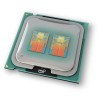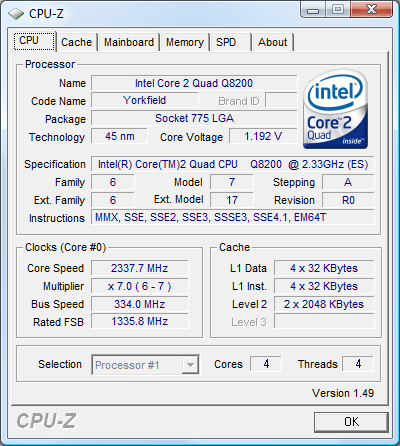- Qualcomm Launches Snapdragon 4 Gen 2 Mobile Platform
- AMD Launches Ryzen PRO 7000 Series Mobile & Desktop Platform
- Intel Launches Sleek Single-Slot Arc Pro A60 Workstation Graphics Card
- NVIDIA Announces Latest Ada Lovelace Additions: GeForce RTX 4060 Ti & RTX 4060
- Maxon Redshift With AMD Radeon GPU Rendering Support Now Available
Q9400S & Q8200S: Intel’s 65W Quad-Cores

The benefits of a low-TDP processor are obvious, but a usual downside is also obvious: low clock speeds. Intel’s changing that thinking with their Core 2 Quad “S” series, which includes the Q9550S, Q9400S and also the Q8200S. Compared to their non-“S” variants, they draw less power and run cooler, all while retaining the performance they’ve become known for.
Page 11 – Power Consumption, Final Thoughts
It goes without saying that power efficiency is at the forefront of many consumers’ minds today, and for good reason. Whether you are trying to save money or the environment – or both – it’s good to know just how much effort certain vendors are putting into their products to help them excel in this area. Both AMD and Intel have worked hard to develop efficient chips, and that’s evident with each new launch. The CPUs are getting faster, and use less power, and hopefully things will stay that way.
To help see what kind of wattage a given processor draws on average, we use a Kill-A-Watt that’s plugged into a power bar that’s in turn plugged into one of the wall sockets, with the test system plugged directly into that. The monitor and other components are plugged into the other socket and is not connected to the Kill-A-Watt. For our system specifications, please refer to our methodology page.
To test, the computer is first boot up and left to sit at idle for five minutes, at which point the current wattage is recorded if stable. To test for full CPU load, IntelBurnTest is run with maximum memory stress for a total of five minutes. During that run, the highest point the wattage reaches on the meter is captured and becomes our “Max Load”. For i7, we use eight instances of SP2004 instead of IntelBurnTest, as the latter is not yet fully compatible with the newer processors.

Though we didn’t have a Q8200 on-hand for comparison, we did have a Q9400, so we were able to directly see the differences in actual power draw from the wall. As you can see, the differences aren’t too great, and to be honest, I expected a bit more. After discussing the issue with Intel, however, I was told that measuring the power straight from the wall isn’t entirely representative of the benefits of a 65W TDP. Over time, greater differences are likely to be seen.
One thing to consider is that IntelBurnTest stresses the processor far more than a regular scenario could (I’d actually be hard-pressed to find any normal application out there that could push the CPU as hard as IBT), and it’s difficult to measure power draw from regular usage. Where idle and load draws are concerned though, not much is supposed to be different. The idle states, for example (C4, C1E, etc) are identical on the “S” version as they are the non-“S” models.
While the differences in power draw from the wall won’t floor anyone, the thermal differences might. With a room temperature of 71°F (Q9400) and 73°F (Q9400S), the “S” model managed to shave an exact 6°C off both the idle and load Core 0 temperatures. It might not seem like much, but pack this CPU into a SFF PC, and any decreases in temperature can be appreciated.
Final Thoughts
When Intel first released their 65W Quad-Core offerings, they were catering to their customers who demanded fast processors with the lowest possible TDP. It wasn’t until a few months after-the-fact that the company decided to release the same CPUs to the general public, and while it’s going to be a niche product, it’s great that they made that decision. Any day that a consumer has a sheer amount of choice available is a good one.
That being said, these processors are a hard sell. It’s difficult to explain the true benefits of a processor with a lower TDP, but those who own or build SFF PC’s understand just how important it is to have as efficient a processor as possible. Normally, this results in an under-performing processor, because people don’t want their PCs to overheat. But with the “S” series, the ability to have both a high-efficiency and high-performance processor is far greater.

Take the Q9400S, for example. At 2.66GHz with 6MB of L2 Cache, it’s no slouch. In fact, it’s a fantastic processor for those who take multi-media seriously, as the added Cache over the Q8200S would make a reasonable difference in most rendering/encoding/converting/etc jobs. Plus, with our IntelBurnTest stress test, which pushes the CPU like no other (you can read more on this in a thread in our forums), the CPU still capped out at 40°C. Even if it is only 6°C different, it’s still a very impressive result.
The fact remains though, if you are not building a PC with constrained space (SFF/USFF), there’s no reason to consider the “S” series. Even in a mid-tower chassis, there would be sufficient airflow to keep temperatures within a normal threshold, so the benefits of an “S” chip wouldn’t be worth the premium price. The “S” series is strictly a CPU for small form-factor PCs, although if you simply want a low-power/low-thermals CPU, it would be beneficial as well. It’s just quite a premium to consider for such gains.
As you can see in the above CPU-Z screenshot, the “S” suffix is not listed under the processor name or specification. Rather, in order to know whether or not a CPU is indeed a 65W model, you’ll need to compare the SPEC code. Normally, revision codes are enough to go by, but in the case of the Q9400 and Q9400S, those are identical, so it’s really impossible to use that as a basis. If you want to purchase an “S” model, be sure to keep these SPEC codes in mind:
- Intel Core 2 Quad Q9550S: SLGAE
- Intel Core 2 Quad Q9550: SLB8V/SLAWQ
- Intel Core 2 Quad Q9400S: SLG9U
- Intel Core 2 Quad Q9400: SLB6B
- Intel Core 2 Quad Q8200S: SLG9T
- Intel Core 2 Quad Q8200: SLB5M
Discuss this article in our forums!
Have a comment you wish to make on this article? Recommendations? Criticism? Feel free to head over to our related thread and put your words to our virtual paper! There is no requirement to register in order to respond to these threads, but it sure doesn’t hurt!
Support our efforts! With ad revenue at an all-time low for written websites, we're relying more than ever on reader support to help us continue putting so much effort into this type of content. You can support us by becoming a Patron, or by using our Amazon shopping affiliate links listed through our articles. Thanks for your support!





